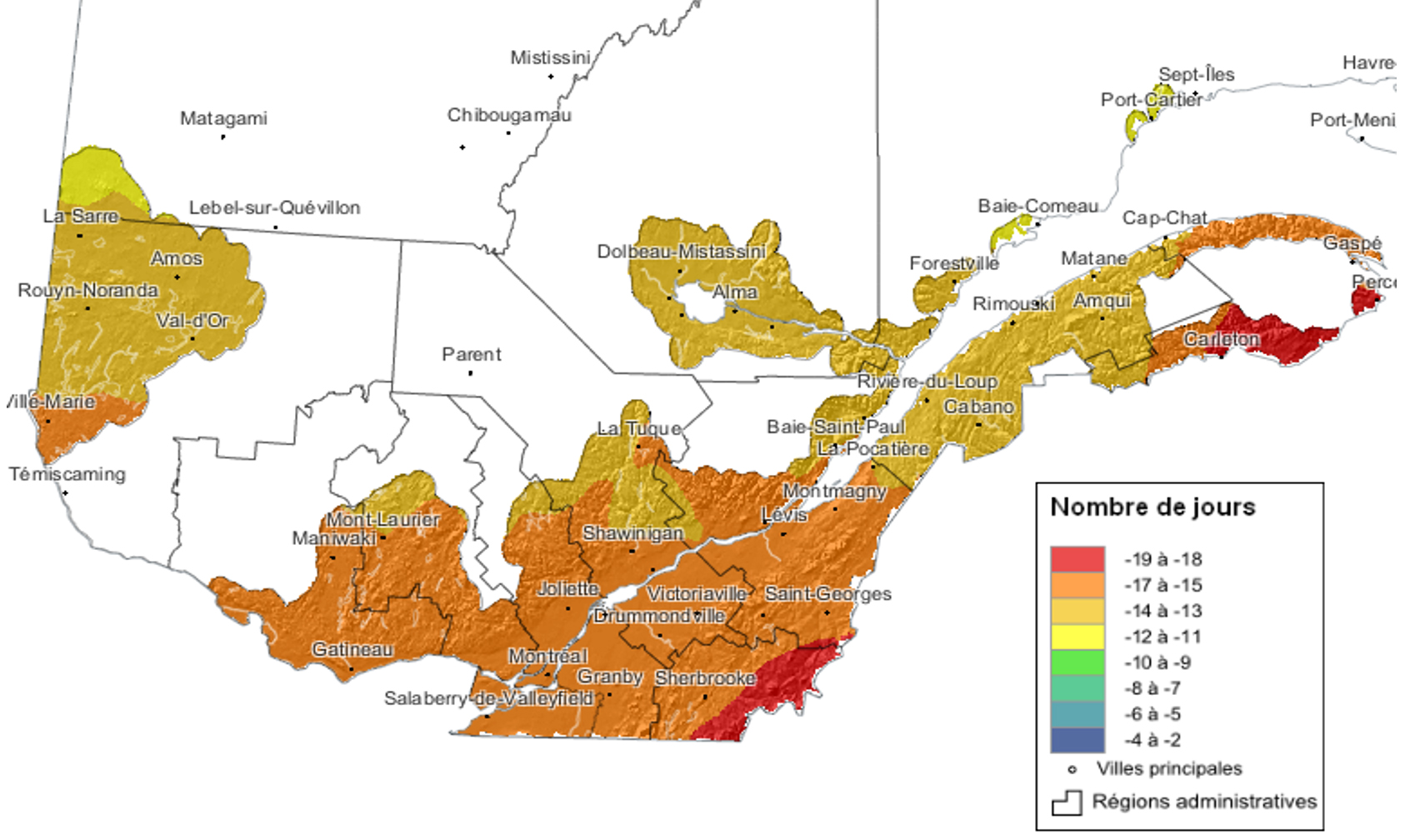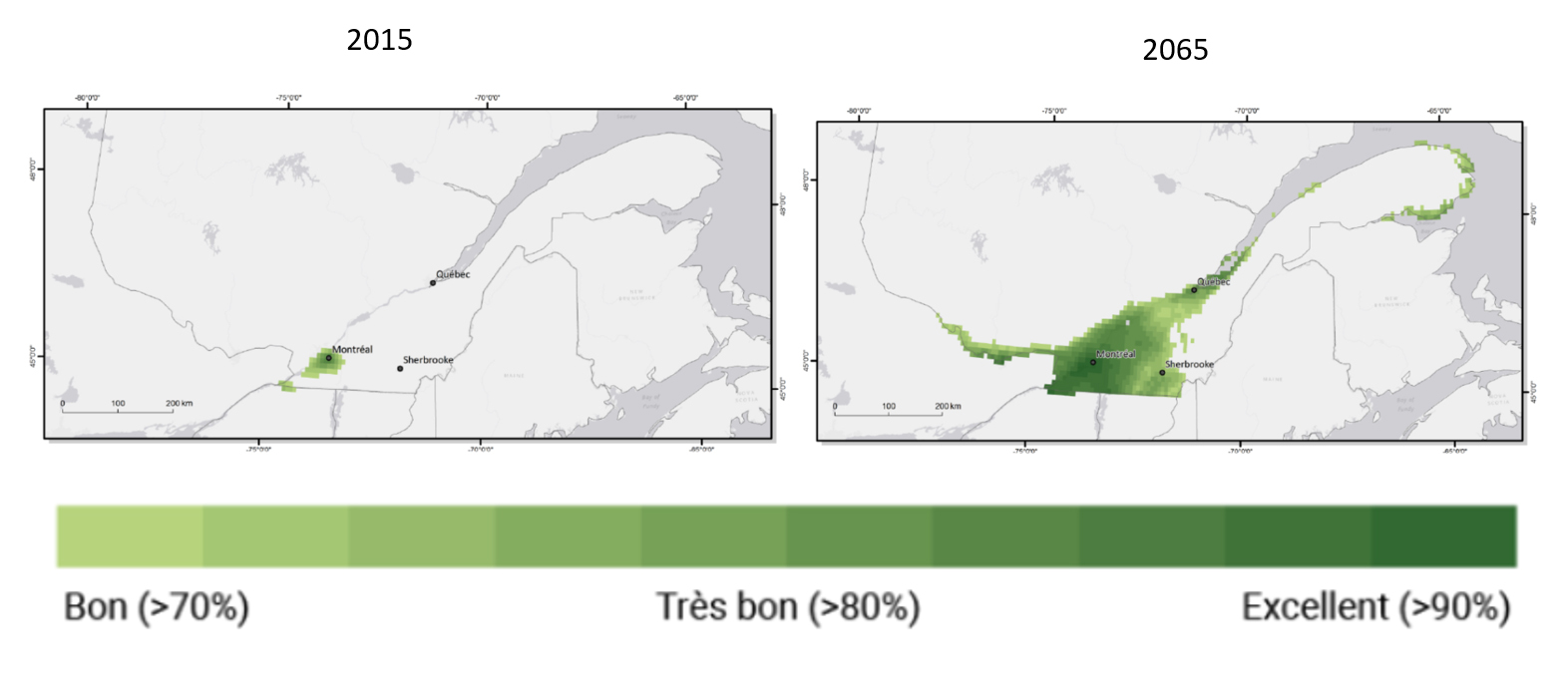Agriculture
Changes in plant growth
By 2050, average annual temperatures in southern Quebec will rise by 2 to 4°C compared to historical values observed between 1981 and 2010. With the last frost of spring arriving earlier and the first frost of autumn occurring later, the growing season will ultimately be longer. This could benefit certain crops such as corn, soybeans and some forage crops. To take advantage of this potentially higher production, practices must be brought into line with the new conditions. For example, the timing or number of annual harvests could be altered, or cultivars more resistant to the future climate could be used. On the other hand, crops grown in cooler regions (canola, barley, wheat, etc.) would suffer from these changes.
According to the Atlas agroclimatique du Québec, under the “high” greenhouse gas emissions scenario, by 2050, certain agricultural regions could see their growing season start more than two weeks earlier compared to 1971-2000.
This tool aims to provide customized climate information and mapping that show the impact of the current and future climates on agricultural systems in order to better guide activities in this sector.

Figure 1: Date of start of the growing season: High change scenario (2041-2070 vs. 1971-2000), Source: Atlas agroclimatique du Québec
Regions that are currently too cold for growing certain crops could see an increase in their agricultural potential. As a result, soil quality and topography permitting, the potential exists for a northerly expansion of certain crops. For example, wine production would be possible in a growing number of Quebec’s regions.

Figure 2: Favourable conditions for wine production: More than 1,000 degree-days, 156 consecutive frost-free days, minimum winter temperatures above -30°C and fewer than 20 days with temperatures below -22°C Source: Alberti-Dufort et al., 2022 (Original source: Roy et al., 2017)
Crop pests and other threats
Despite certain advantages for crop growth that a warmer climate might offer, negative impacts are also anticipated, which could partially offset these gains. Farmers have always had to deal with crop pests and other threats such as diseases or weeds. Changes in the climate could have a major impact on the abundance and range of such pests.
In this context, a number of species that are naturally present in Quebec may proliferate even more, in addition to being joined by exotic invasive species as the latter expand their ranges northward. This could increase the risk of crop damage and therefore influence the use of pesticides, which could have repercussions on both the quality of the environment and human health.
Adaptation of Phytosanitary Measures for Pests and Diseases of Fruit Crops in Regard to Climate Change Impacts
The knowledge resulting from this project will enable the development or revision of planning and action tools for decision makers in order to assist the crop protection sector to adapt to climate change.
Impact of Climate Change and Adaptation Measures on Present and Potential Future Field Crop Pests in Quebec
The knowledge gained from this project will allow the development or revision of planning and action tools for decision makers in order to promote the adaptation of the crop protection sector to climate change.
Detrimental climate events
Climate change will also translate into an increase in extreme temperatures, extreme precipitation events, more severe droughts as well as an increase in freeze-thaw episodes in winter. Periods of intense heat affect both crops and livestock. The latter can sustain physical stress due to heat, diminishing their productivity and well-being.
More frequent freeze-thaw events in winter is another factor that can undermine productivity. Indeed, periods of winter cold fronts in the absence of snow that would normally protect the root systems of plants make the latter more vulnerable to frost, which increases mortality. Particularly affected by such climate events are certain perennial forage crops often used to feed livestock.
Climate projections indicate an increase in both extreme precipitation events and drought-like periods of low precipitation.
On one hand, heavy precipitation can damage crops and fields by triggering soil erosion and surface runoff, resulting in nutrients and pesticides being carried to adjacent water bodies. On the other hand, droughts cause stress due to the lack of water for crops and place pressure on all water users, which reduces the volume available for agriculture.
Choice of Forage Grass and Mitigation of Heat Stress for Cows on Quebec Dairy Farms in the Context of Climate Change
The results obtained make it possible to provide dairy farm managers with concrete recommendations for choosing forage mixes adapted to current and future climate conditions and solutions to reduce the risk of heat stress in barns during hot summer weather.
Emerging issues in the food system
The impacts that climate change is having on agriculture elsewhere in the world are also considered an issue for Quebec, as the province consumes a number of imported foods. More frequent droughts, flooding or even major forest fires in the countries of origin of these imports can have a ripple effect on the availability of foods and their cost in our grocery stores. It is often the most disadvantaged populations that are the most affected.